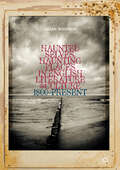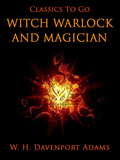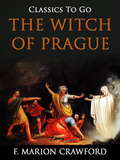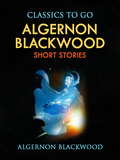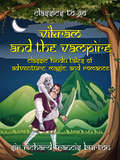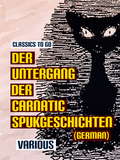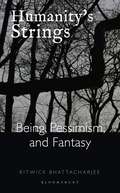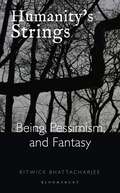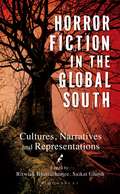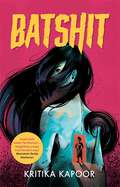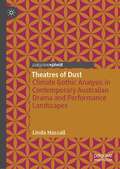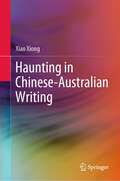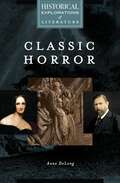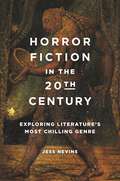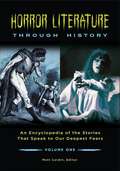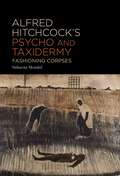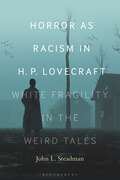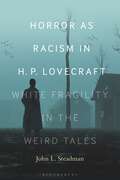- Table View
- List View
Haunted Selves, Haunting Places in English Literature and Culture: 1800–Present
by Julian WolfreysHaunted Selves, Haunting Places in English Literature and Culture offers a series of readings of poetry, the novel and other forms of art and cultural expression, to explore the relationship between subject and landscape, self and place. Utilizing an interdisciplinary approach grounded in close reading, the text places Jacques Derrida’s work on spectrality in dialogue with particular aspects of phenomenology. The volume explores writing and culture from the 1880s to the present day, proceeding through four sections examining related questions of identity, memory, the landscape, and our modern relationship to the past. Julian Wolfreys presents a theoretically informed understanding of the efficacy of literature and culture in connecting us to the past in an affective and engaged manner.
Witch, Warlock, and Magician: Historical Sketches Of Magic And Witchcraft In England And Scotland (Classics To Go)
by W. H. Davenport AdamsIt was not the author's purpose in this volume to attempt a general history of magic and alchemy, or a scientific inquiry into their psychological aspects. He confined himself to a sketch of their progress in England and to a narrative of the lives of our principal magicians. It is also devoted to a historical review of witchcraft in Great Britain, and an examination into the most remarkable witch trials. (Excerpt from Goodreads)
The Witch of Prague: A Fantastic Tale (Classics To Go)
by F. Marion CrawfordExcerpt: "A great multitude of people filled the church, crowded together in the old black pews, standing closely thronged in the nave and aisles, pressing shoulder to shoulder even in the two chapels on the right and left of the apse, a vast gathering of pale men and women whose eyes were sad and in whose faces was written the history of their nation. The mighty shafts and pilasters of the Gothic edifice rose like the stems of giant trees in a primeval forest from a dusky undergrowth, spreading out and uniting their stony branches far above in the upper gloom. From the clerestory windows of the nave an uncertain light descended halfway to the depths and seemed to float upon the darkness below as oil upon the water of a well. Over the western entrance the huge fantastic organ bristled with blackened pipes and dusty gilded ornaments of colossal size, like some enormous kingly crown long forgotten in the lumber room of the universe, tarnished and overlaid with the dust of ages. Eastwards, before the rail which separated the high altar from the people, wax torches, so thick that a man might not span one of them with both his hands, were set up at irregular intervals, some taller, some shorter, burning with steady, golden flames, each one surrounded with heavy funeral wreaths, and each having a tablet below it, whereon were set forth in the Bohemian idiom, the names, titles, and qualities of him or her in whose memory it was lighted. Innumerable lamps and tapers before the side altars and under the strange canopied shrines at the bases of the pillars, struggled ineffectually with the gloom, shedding but a few sickly yellow rays upon the pallid faces of the persons nearest to their light."
Short Stories: A Volume Of Nature Stories (Classics To Go)
by Algernon BlackwoodThis collection includes eight of the best stories from Algernon Blackwood. The Wendigo, The Damned, The Man, Schooldays, Julius LeVallon, Edinburgh, The Châlet in the Jura Mountains, The Attempted Restitution. S. T. Joshi has stated that "his work is more consistently meritorious than any weird writer's except Dunsany's" and that his short story collection Incredible Adventures "may be the premier weird collection of this or any other century".
Vikram and the Vampire Classic Hindu Tales of Adventure, Magic, and Romance: Classic Hindu Tales Of Adventure, Magic, And Romance (Classics To Go)
by Richard Francis BurtonVikram and the Vampire, translated and adapted by Sir Richard Burton, is a group of tales told by a baital (not really a vampire but a kind of spirit who can inhabit dead bodies) to King Vikram (described by Burton as the King Arthur of India). The stories are somewhat in the style of the tales of the Arabian Nights. (Goodreads)
Der Untergang der Carnatic Spukgeschichten (Classics To Go)
by VariousSpukgeschichten von Gebrüder Grimm, Wilhelm Hauff, Friedrich Gerstäcker, Paul Heyse, A. J. Mordtmann, Heinrich Zschokkke
Hijas del horror : Rocío Silva Santisteban y Regina José Galindo : mujer, testimonio y violencia en la poesía y la performance
by Bethsabé Huamán AndíaHumanity's Strings: Being, Pessimism, and Fantasy
by Ritwick BhattacharjeeHumanity's Strings: Being, Pessimism, and Fantasy interrogates the nature of reality against fantasy as the two are presented to and created by the human consciousness-a consciousness that is in constant struggle with the omnipresence of misery and the inevitability of death. The book shows that being, pessimism, and fantasy as the strings which are made up of forces unseen, unknown, and ungoverned that control the human being like a puppet. Through a study of the metaphysical and existential philosophies of thinkers, such as Franz Brentano, Edmund Husserl, Søren Kierkegaard, Arthur Schopenhauer, Friedrich Nietzsche, and Jacques Derrida, the book interrogates not only how the self interacts with fantasy but why it does as well. It also asks why fantasy forces the self towards a unity that impacts existence in the modern world with its questions of justice, politics, and materiality. Furthermore, it situates the fantasy novels of authors, such as Stephen King, Brandon Sanderson, Douglas Adams, and Robert Jordan, as discourses which delineate the considerations above as ideas which modulate the existence of the human. Additionally, the book shows how it is not just the human that is affected by the machinations of the cosmos but also time and space-ostensibly a priori entities of existence-as these two interact with the human and its consciousness.
Humanity's Strings: Being, Pessimism, and Fantasy
by Ritwick BhattacharjeeHumanity's Strings: Being, Pessimism, and Fantasy interrogates the nature of reality against fantasy as the two are presented to and created by the human consciousness-a consciousness that is in constant struggle with the omnipresence of misery and the inevitability of death. The book shows that being, pessimism, and fantasy as the strings which are made up of forces unseen, unknown, and ungoverned that control the human being like a puppet. Through a study of the metaphysical and existential philosophies of thinkers, such as Franz Brentano, Edmund Husserl, Søren Kierkegaard, Arthur Schopenhauer, Friedrich Nietzsche, and Jacques Derrida, the book interrogates not only how the self interacts with fantasy but why it does as well. It also asks why fantasy forces the self towards a unity that impacts existence in the modern world with its questions of justice, politics, and materiality. Furthermore, it situates the fantasy novels of authors, such as Stephen King, Brandon Sanderson, Douglas Adams, and Robert Jordan, as discourses which delineate the considerations above as ideas which modulate the existence of the human. Additionally, the book shows how it is not just the human that is affected by the machinations of the cosmos but also time and space-ostensibly a priori entities of existence-as these two interact with the human and its consciousness.
Horror Fiction in the Global South: Cultures, Narratives and Representations
by NoneHorror Fiction in the Global South: Cultures, Narratives, and Representations believes that the experiences of horror are not just individual but also/simultaneously cultural. Within this understanding, literary productions become rather potent sites for the relation of such experiences both on the individual and the cultural front. It's not coincidental, then, that either William Blatty's The Exorcist or Gabriel Garcia Marquez's One Hundred Years of Solitude become archetypes of the re-presentations of the way horror affects individuals placed inside different cultures. Such an affectation, though, is but a beginning of the ways in which the supernatural interacts with the human and gives rise to horror. Considering that almost all aspects of what we now designate as the Global North, and its concomitant, the Global South – political, historical, social, economic, cultural, and so on – function as different paradigms, the experiences of horror and their telling in stories become functionally different as well. Added to this are the variations that one nation or culture of the east has from another. The present anthology of essays, in such a scheme of things, seeks to examine and demonstrate these cultural differences embedded in the impact that figures of horror and specters of the night have on the narrative imagination of storytellers from the Global South. If horror has an everyday presence in the phenomenal reality that Southern cultures subscribe to, it demands alternative phenomenology. The anthology allows scholars and connoisseurs of Horror to explore theoretical possibilities that may help address precisely such a need.
Batshit
by Kritika KapoorTwenty-something Pia Bhandari has the ideal life – or so it seems. As long as she puts on a happy face, no one is any the wiser about the sinister voices in her head. Not her boyfriend Raghav, or her soon-to-be-married younger sister Khushi, her long-time psychiatrist Dr Agarwal, her father Ajit or even her mother Neeta, who is otherwise obsessed with controlling her daughter’s life.But Pia’s demons follow her wherever she goes. One yellow-eyed demon in particular. Feral and bloodthirsty, it threatens to rip through Pia’s life, leaving a murderous trail in its wake. Hurtling between the opulent kothis of GK-2 to the plush bungalows of Sainik Farms, this twisted tale about a Delhi girl’s fight against the dark forces is about to get batshit.
Theatres of Dust: Climate Gothic Analysis in Contemporary Australian Drama and Performance Landscapes
by Linda HassallThrough a contemporary Gothic lens, the book explores theatre theories, processes and practices that explore; the impacts of continuing drought and natural disaster, the conflicts concerning resource extraction and mining and current political debates focussed on climate change denial. While these issues can be argued from various political and economic platforms, theatrical investigations as discussed here suggest that scholars and theatre makers are becoming empowered to dramaturgically explore the ecological challenges we face now and may face in the future. In doing so the book proposes that theatre can engage in not only climate change analysis and discussion but can develop climate literacies in a broader socio-cultural context.
Haunting in Chinese-Australian Writing
by Xiao XiongThis book examines haunting in terms of trauma, languaging, and the supernatural in works by Chinese Australian writers born in Australia, Mainland China, Hong Kong, Malaysia, and Singapore. It goes beyond the conventional focus on identity issues in the analysis of diasporic writing, considering how the memory of past trauma is triggered by abusive systems of power in the present. The author unpacks how trauma also brings past violence to haunt the present. This book considers how different Chinese diasporic communities present a dynamic and multiple state through partial erasure between different Chinese subcultures and other cultures.Showing the supernatural as a social and cultural product, this book elucidates how haunting as the supernatural refers to the coexistence of, and the competition between, different cultures and powers. It takes a wide-ranging view of different diasporic communities under the banner ‘Chinese’, a term that refers not only to Chinese nationals in terms of citizenship, but also to the Chinese diaspora in terms of ancestry, and Chinese culture more generally. In analysing haunting in texts, the author positions Chinese culture as in a constant state of flux. It is relevant to literary scholars and students with interests in Australian literature, Chinese and Southeast Asian migration writing, and those with an interest in the Gothic and postcolonial traditions.
Classic Horror: A Historical Exploration of Literature (Historical Explorations of Literature)
by Anne DeLongA valuable resource for readers exploring the classic horror genre, this book presents primary source documents alongside analysis in an examination of the social, political, and economic factors reflected in 19th century Gothic literature.The nineteenth century was a time of social, cultural, and economic change; revolutionary scientific developments; and enduring imaginative works. This book explores the classic horror genre of Gothic literature in its historical and social contexts. It contains chapters on four major works of classic horror, with each chapter providing a mix of background information, primary source historical documents, and analysis that will appeal as much to high school and college students as to lovers of literature and the Victorian era.Coleridge's The Rime of the Ancient Mariner is contextualized through documents pertaining to British imperialism, Antarctic Exploration, and the burgeoning environmentalist movement. Shelley's Frankenstein is explored through sections on galvanism, electricity, grave robbing, and the vitalist debate. Stevenson's The Strange Case of Dr. Jekyll and Mr. Hyde is read through explanations of nineteenth-century drug use and addiction and early theories of psychology and criminology. Stoker's Dracula is studied with reference to such topics as mesmerism, clairvoyance, alienism, medical ethics, xenophobia, and Victorian pseudoscience.
Horror Fiction in the 20th Century: Exploring Literature's Most Chilling Genre
by Jess NevinsProviding an indispensable resource for academics as well as readers interested in the evolution of horror fiction in the 20th century, this book provides a readable yet critical guide to global horror fiction and authors.Horror Fiction in the 20th Century encompasses the world of 20th-century horror literature and explores it in a critical but balanced fashion. Readers will be exposed to the world of horror literature, a truly global phenomenon during the 20th century. Beginning with the modern genre's roots in the 19th century, the book proceeds to cover 20th-century horror literature in all of its manifestations, whether in comics, pulps, paperbacks, hardcover novels, or mainstream magazines, and from every country that produced it. The major horror authors of the century receive their due, but the works of many authors who are less well-known or who have been forgotten are also described and analyzed. In addition to providing critical assessments and judgments of individual authors and works, the book describes the evolution of the genre and the major movements within it. Horror Fiction in the 20th Century stands out from its competitors and will be of interest to its readers because of its informed critical analysis, its unprecedented coverage of female authors and writers of color, and its concise historical overview.
Horror Literature through History [2 volumes]: An Encyclopedia of the Stories That Speak to Our Deepest Fears [2 volumes]
by Editor Matt CardinThis two-volume set offers comprehensive coverage of horror literature that spans its deep history, dominant themes, significant works, and major authors, such as Stephen King, Edgar Allan Poe, and Anne Rice, as well as lesser-known horror writers.Many of today's horror story fans—who appreciate horror through movies, television, video games, graphic novels, and other forms—probably don't realize that horror literature is not only one of the most popular types of literature but one of the oldest. People have always been mesmerized by stories that speak to their deepest fears. Horror Literature through History shows 21st-century horror fans the literary sources of their favorite entertainment and the rich intrinsic value of horror literature in its own right. Through profiles of major authors, critical analyses of important works, and overview essays focused on horror during particular periods as well as on related issues such as religion, apocalypticism, social criticism, and gender, readers will discover the fascinating early roots and evolution of horror writings as well as the reciprocal influence of horror literature and horror cinema.This unique two-volume reference set provides wide coverage that is current and compelling to modern readers—who are of course also eager consumers of entertainment. In the first section, overview essays on horror during different historical periods situate works of horror literature within the social, cultural, historical, and intellectual currents of their respective eras, creating a seamless narrative of the genre's evolution from ancient times to the present. The second section demonstrates how otherwise unrelated works of horror have influenced each other, how horror subgenres have evolved, and how a broad range of topics within horror—such as ghosts, vampires, religion, and gender roles—have been handled across time. The set also provides alphabetically arranged reference entries on authors, works, and specialized topics that enable readers to zero in on information and concepts presented in the other sections.
Alfred Hitchcock’s Psycho and Taxidermy: Fashioning Corpses
by Subarna MondalThere are numerous scholarly works on Alfred Hitchcock's Psycho (1960). Some of these works have explored its Gothic potentials. However, no detailed effort has yet been made to explore one of its major motifs – taxidermy. Taxidermy as an art of corporeal preservation has effectively been used in mainstream body horror films years after Psycho was released. Yet Psycho was one of the first films to explore its potentials in the Gothic genre at a time when it was relegated to a low form of art. Alfred Hitchcock's Psycho and Taxidermy focuses on taxidermy as a cultural practice in both Victorian and modern times and how it has been employed both metaphorically and literally in Hitchcock's films, especially Psycho. It also situates Psycho as a crucial film in the filmic continuum of body horrors where death and docility share a troubled relationship.
Alfred Hitchcock’s Psycho and Taxidermy: Fashioning Corpses
by Subarna MondalThere are numerous scholarly works on Alfred Hitchcock's Psycho (1960). Some of these works have explored its Gothic potentials. However, no detailed effort has yet been made to explore one of its major motifs – taxidermy. Taxidermy as an art of corporeal preservation has effectively been used in mainstream body horror films years after Psycho was released. Yet Psycho was one of the first films to explore its potentials in the Gothic genre at a time when it was relegated to a low form of art. Alfred Hitchcock's Psycho and Taxidermy focuses on taxidermy as a cultural practice in both Victorian and modern times and how it has been employed both metaphorically and literally in Hitchcock's films, especially Psycho. It also situates Psycho as a crucial film in the filmic continuum of body horrors where death and docility share a troubled relationship.
Horror as Racism in H. P. Lovecraft: White Fragility in the Weird Tales
by Dr. or Prof. John L. SteadmanProviding a new perspective on Lovecraft's life and work, Horror as Racism in H.P. Lovecraft focuses on the overlap between the writer's personal beliefs and the racist images and narratives in his speculative fiction. Building on recent debates about Lovecraft and drawing on the concept of "white fragility," John Steadman argues that the writer's fiction reflects his feelings of resentment and anger towards non-white persons and was used to advocate for his racist, xenophobic political beliefs – that western civilization was in decline and slavery was justifiable among "superior" civilizations. In making these claims, Lovecraft's tales pit humans against extra-terrestrial aliens, developing a terrifying, futuristic vision of the Earth as a plantation planet. The familiar image of Lovecraft as a reclusive, creative genius and mentor to young writer-friends is dismantled through close readings of his fiction and nonfiction – including correspondence, essays, and poetry – and examination of his early biography. This image is replaced by that of a cruel, callous, and, at times, psychotic man, a violently vitriolic racist and white supremacist who hated most of the non-white races. While some will dismiss the author outright and others will read his fiction but ignore the racism, Horror as Racism in H.P. Lovecraft takes a middle ground: acknowledging Lovecraft's personal history and heinous intentions, it helps readers navigate the author's disturbing biography while also getting a better sense of the stories, which remain significant within American science fiction.
Horror as Racism in H. P. Lovecraft: White Fragility in the Weird Tales
by Dr. or Prof. John L. SteadmanProviding a new perspective on Lovecraft's life and work, Horror as Racism in H.P. Lovecraft focuses on the overlap between the writer's personal beliefs and the racist images and narratives in his speculative fiction. Building on recent debates about Lovecraft and drawing on the concept of "white fragility," John Steadman argues that the writer's fiction reflects his feelings of resentment and anger towards non-white persons and was used to advocate for his racist, xenophobic political beliefs – that western civilization was in decline and slavery was justifiable among "superior" civilizations. In making these claims, Lovecraft's tales pit humans against extra-terrestrial aliens, developing a terrifying, futuristic vision of the Earth as a plantation planet. The familiar image of Lovecraft as a reclusive, creative genius and mentor to young writer-friends is dismantled through close readings of his fiction and nonfiction – including correspondence, essays, and poetry – and examination of his early biography. This image is replaced by that of a cruel, callous, and, at times, psychotic man, a violently vitriolic racist and white supremacist who hated most of the non-white races. While some will dismiss the author outright and others will read his fiction but ignore the racism, Horror as Racism in H.P. Lovecraft takes a middle ground: acknowledging Lovecraft's personal history and heinous intentions, it helps readers navigate the author's disturbing biography while also getting a better sense of the stories, which remain significant within American science fiction.
